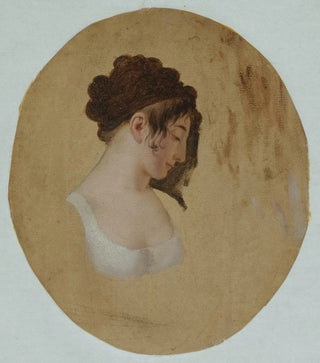Art print | Profile of a young woman's head - Louis Léopold Boilly


View from behind

Frame (optional)
Captivating introduction
In the rich and complex universe of 19th-century French art, the work of Louis Léopold Boilly stands out for its ability to capture the very essence of Parisian life. The art print Profil de la tête d'une jeune femme - Louis Léopold Boilly is a perfect illustration of his exceptional talent. This piece, imbued with delicacy and finesse, invites the viewer to delve into the inner world of a young woman, both mysterious and accessible. The way Boilly manages to seize human emotion through portraiture is simply fascinating, transforming a simple image into a true visual narrative.
Style and uniqueness of the work
Boilly's style is characterized by meticulous attention to detail and an impressive mastery of light and shadow. In Profil de la tête d'une jeune femme, each brushstroke reveals a unique sensitivity, where the softness of contours blends with striking expressiveness. The young woman, whose gaze seems to capture the soul, is depicted with a natural elegance that transcends time. Boilly uses delicate, almost pastel colors, which enhance the beauty of his subject while creating an intimate atmosphere. This portrait does not merely reproduce an image; it evokes an emotion, a story, a fleeting moment of daily life. The choice of profile, for its part, gives the work a contemplative dimension, encouraging the viewer to reflect on the personality of this woman, and by extension, on the condition of women of her time.
The artist and his influence
Louis Léopold Boilly, born in 1761, is an emblematic figure of the artistic movement that emerged at the end of the 18th century and the beginning of the 19th century. His artistic journey is marked by innovations and experiments, making him a pioneer in the representation of modern life. Boilly was able to capture the changes in French society, from Parisian salons to scenes of everyday life, while incorporating elements of realism and romanticism. His influence extends well beyond his era, inspiring many artists who followed in his footsteps. As a witness of his time

Matte finish

View from behind

Frame (optional)
Captivating introduction
In the rich and complex universe of 19th-century French art, the work of Louis Léopold Boilly stands out for its ability to capture the very essence of Parisian life. The art print Profil de la tête d'une jeune femme - Louis Léopold Boilly is a perfect illustration of his exceptional talent. This piece, imbued with delicacy and finesse, invites the viewer to delve into the inner world of a young woman, both mysterious and accessible. The way Boilly manages to seize human emotion through portraiture is simply fascinating, transforming a simple image into a true visual narrative.
Style and uniqueness of the work
Boilly's style is characterized by meticulous attention to detail and an impressive mastery of light and shadow. In Profil de la tête d'une jeune femme, each brushstroke reveals a unique sensitivity, where the softness of contours blends with striking expressiveness. The young woman, whose gaze seems to capture the soul, is depicted with a natural elegance that transcends time. Boilly uses delicate, almost pastel colors, which enhance the beauty of his subject while creating an intimate atmosphere. This portrait does not merely reproduce an image; it evokes an emotion, a story, a fleeting moment of daily life. The choice of profile, for its part, gives the work a contemplative dimension, encouraging the viewer to reflect on the personality of this woman, and by extension, on the condition of women of her time.
The artist and his influence
Louis Léopold Boilly, born in 1761, is an emblematic figure of the artistic movement that emerged at the end of the 18th century and the beginning of the 19th century. His artistic journey is marked by innovations and experiments, making him a pioneer in the representation of modern life. Boilly was able to capture the changes in French society, from Parisian salons to scenes of everyday life, while incorporating elements of realism and romanticism. His influence extends well beyond his era, inspiring many artists who followed in his footsteps. As a witness of his time






